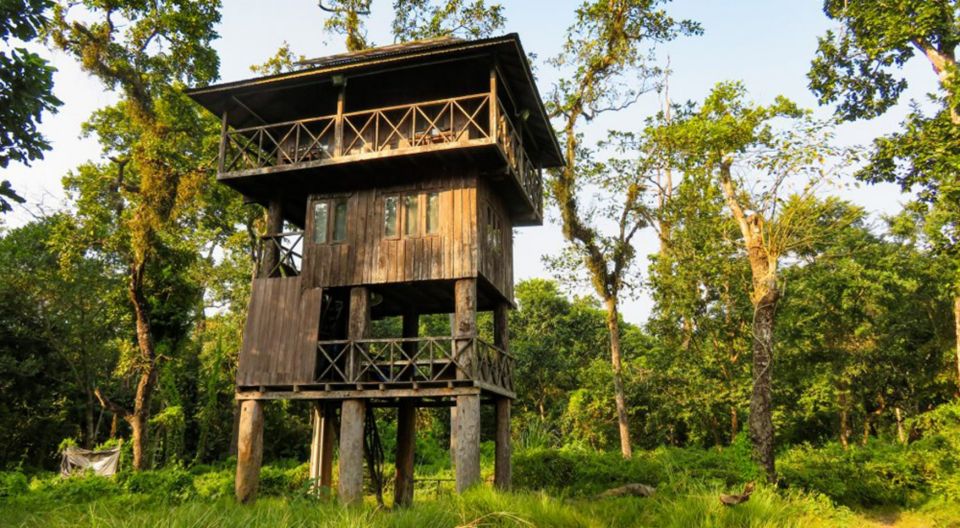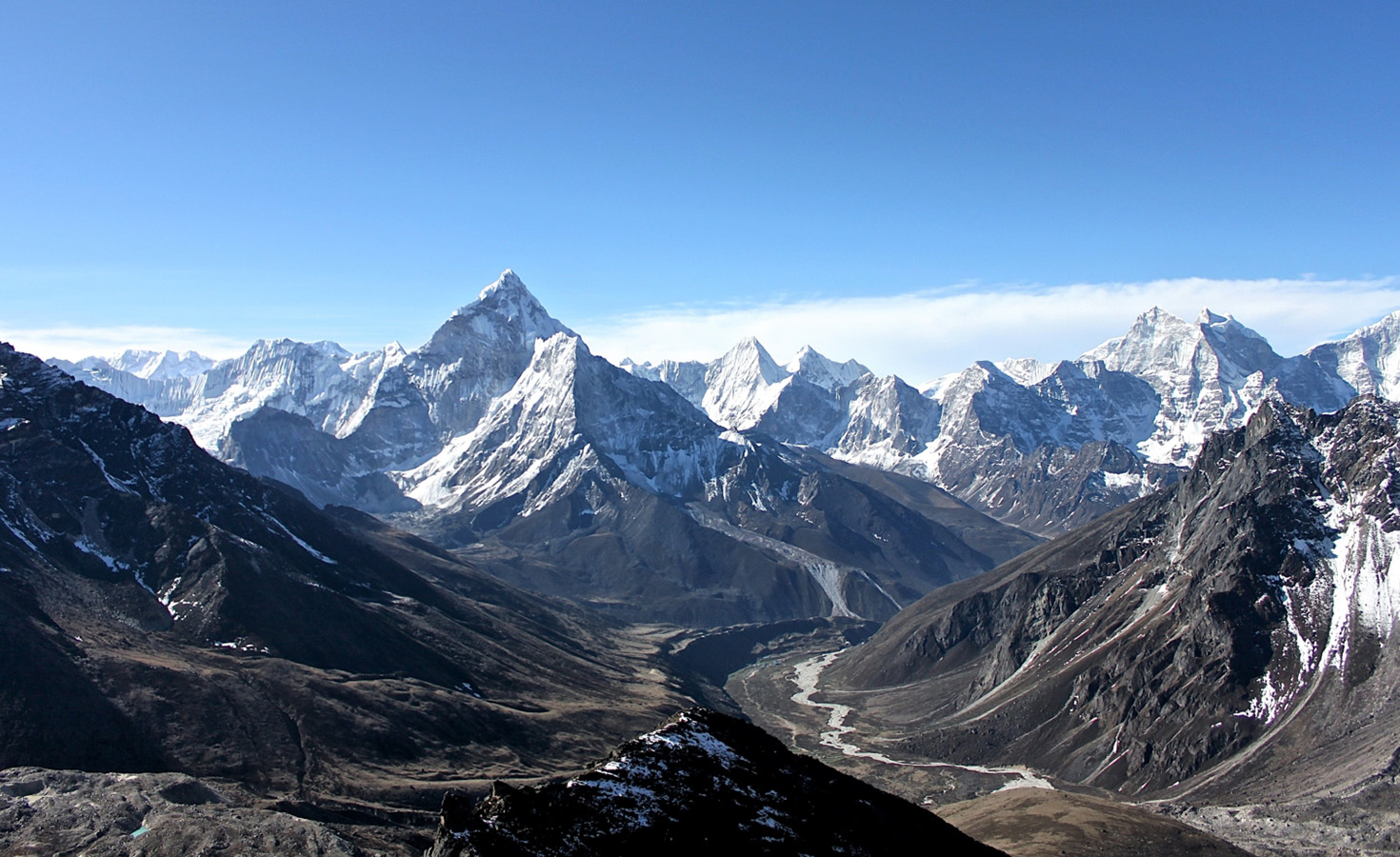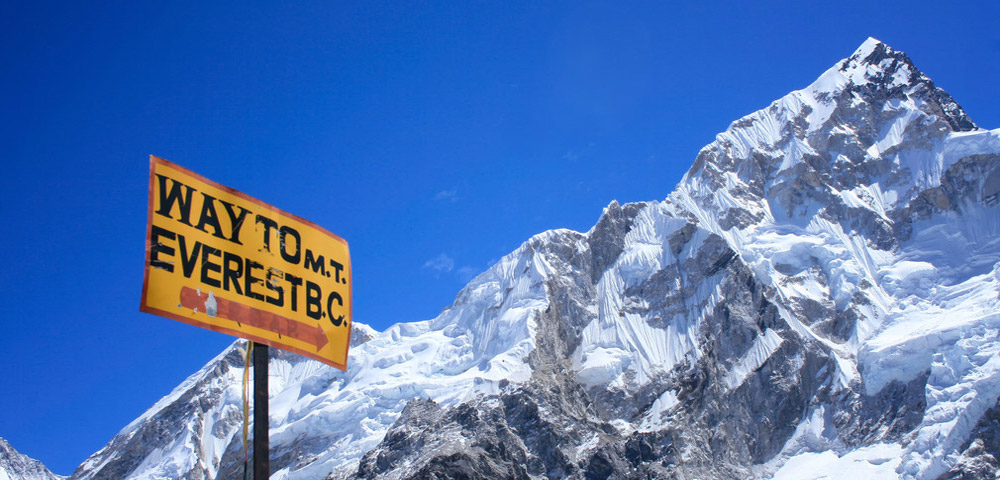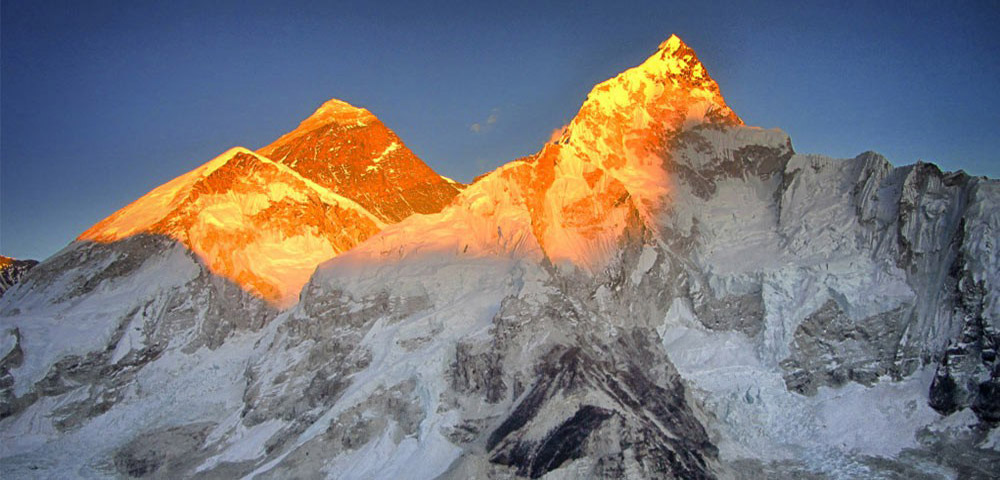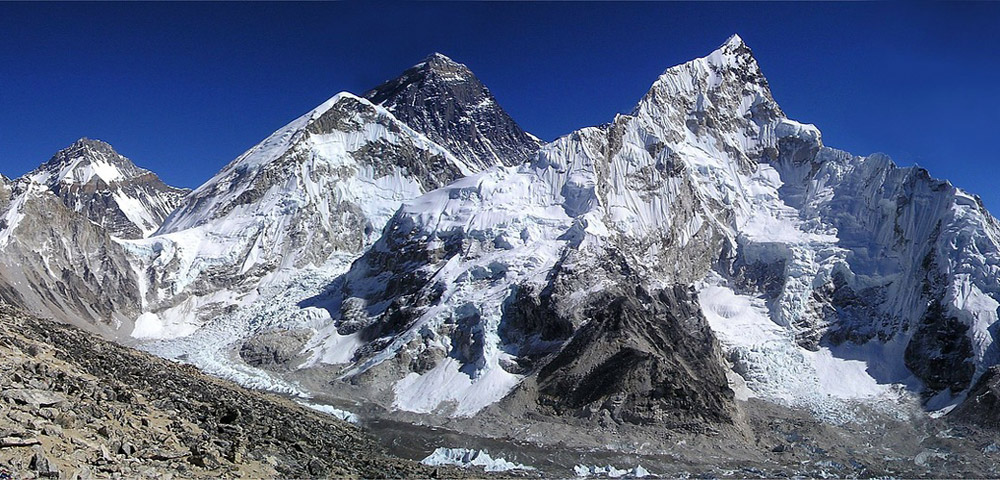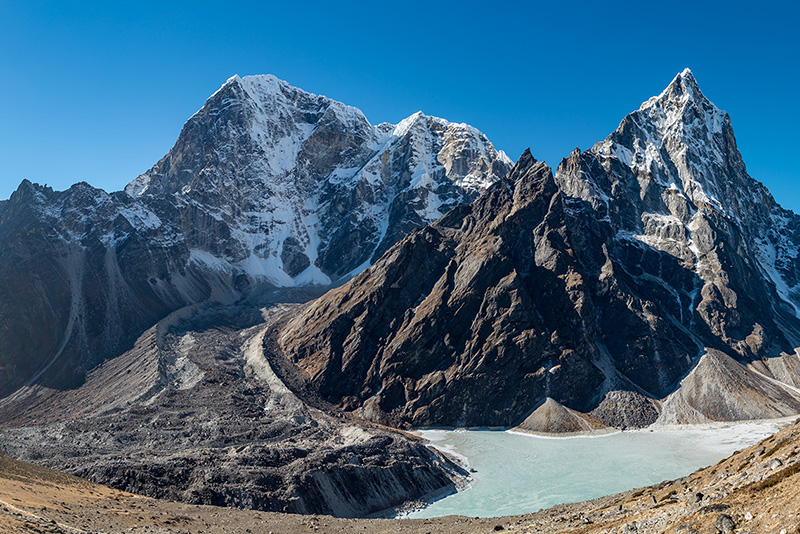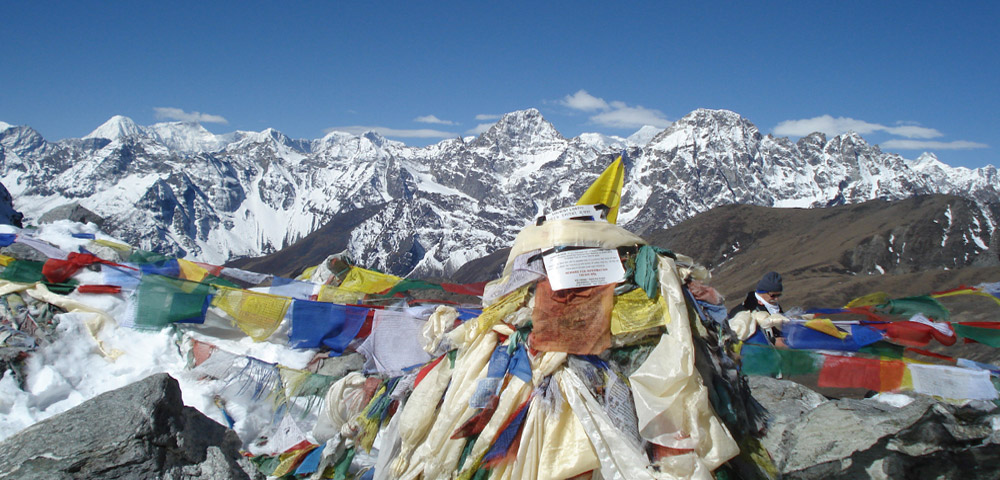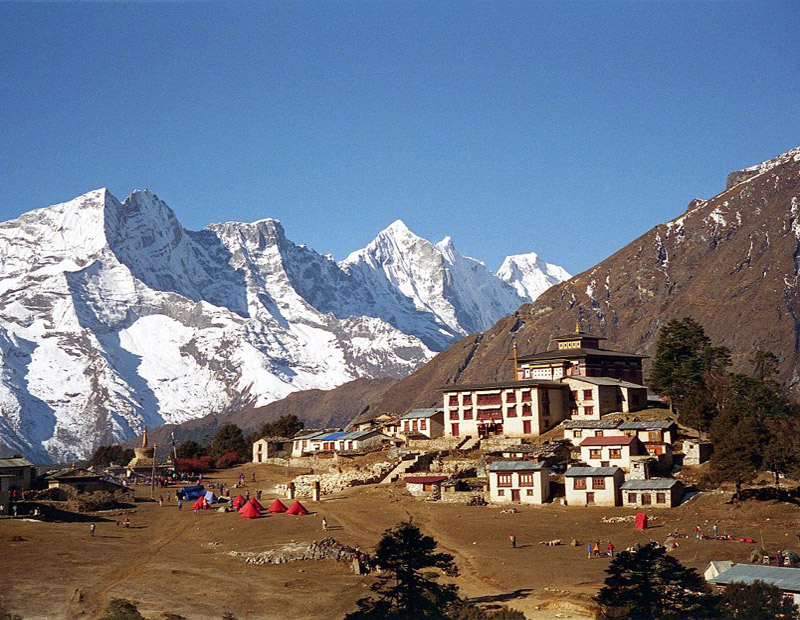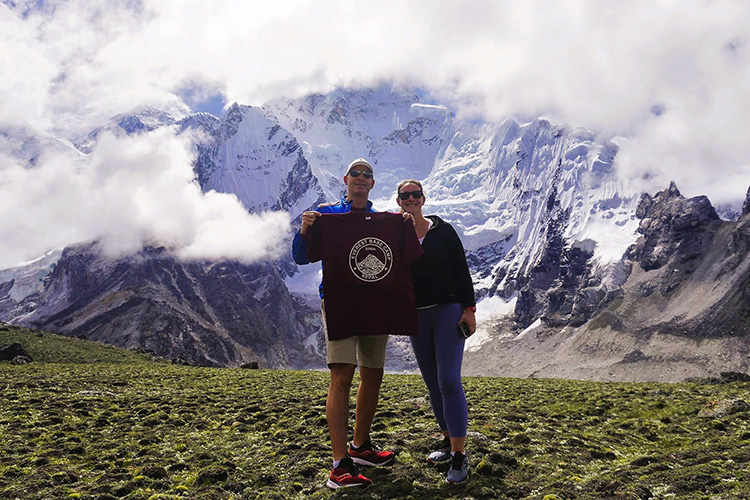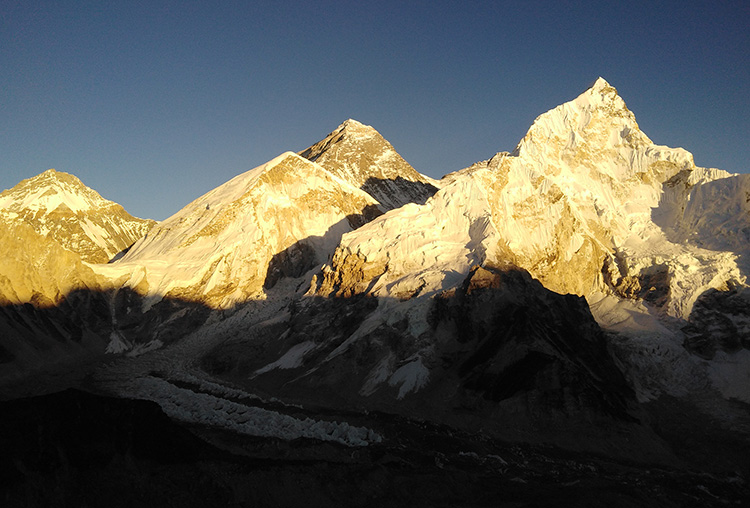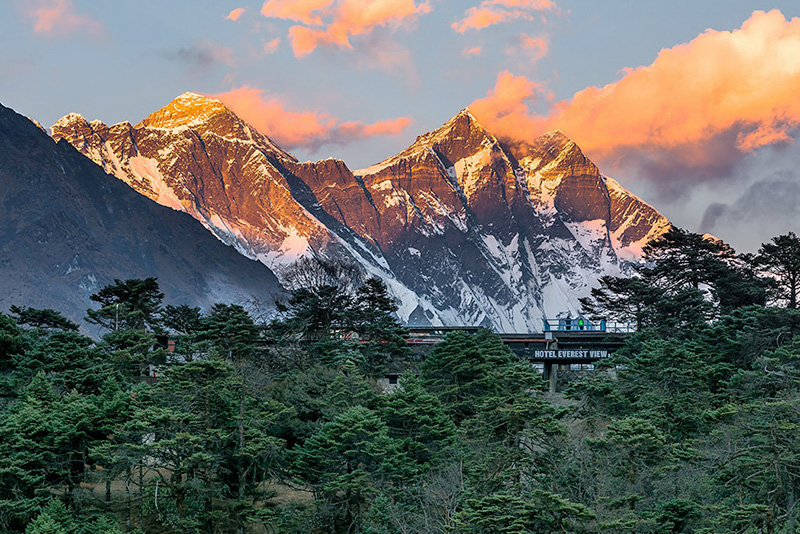Everest Base Camp Trek
The Everest Base Camp Trek is not only a trek but lifetime adventure experience and it is one of the most popular treks in the World. Everest Base Camp Trek-in short, the EBC Trek-is one of the best hikes in the world, and we are offering a 14 Days Everest Base Camp Trekking package at a very affordable cost.
Everest Base Camp Trekking is one of the famous treks in the world. During 14 days at Everest Base Camp Trek, we experience the amazing mountain views, glimpses of Sherpa people and Sagarmatha National Park, and visit high-altitude Buddhist monasteries.
The best-selling trekking package for Getaway Nepal Adventure is the Everest Base Camp Trekking package. We have prepared a standard 14-day Everest Base camp Trekking package for both beginner and regular trekkers, including enough acclimatization days. Our 14-day Everest Trek begins with the 35-minute scenic flight to Lukla, with a small Twin Otter plane from Kathmandu.
Upon arrival at Lukla Airport, your guide welcomes you and introduces other members of the team. After a short break and having breakfast, we begin our journey toward Phakding. Crossing the highest Hillary Bridge and climbing up towards Namche Bazaar itself is glorious-a part of the Everest Base Camp Trek. The Everest Base Camp Trekking route will pass by many viewpoints, villages, monasteries, and glaciers to the foot of Mt. Everest for one of the most remarkable experiences of your lifetime. The 14 Days Everest Base Camp Trek is a magnificent taste of Tibetan culture at an incredibly high altitude, wonderfully colored vistas of rhododendron woods, and gigantic views of the Himalayas-including the world’s tallest peak, Mt Everest. This breathtaking trek starts from Lukla (2840m) via Phakding (2610m) to Namche Bazar (3440m), Phortse Village (3810m), Dingboche (4260m), Duglha (4620m), Lobuche (4190m), Gorakshep (5140m), Kalapatthar (5545m), upto Mt. Everest base camp (5364m).
Whether you scale towering peaks or make your way through scenic valleys, this map holds a wealth of knowledge regarding the elevation level. The use of such an invaluable resource will help you make crucial decisions to ensure a safer and more enjoyable journey. Understand what heights you will be scaling and begin your trek with clarity and confidence.
Table of Contents
- Trekking Highlights
- What to expect on 14 Days Everest Base Camp Trek
- 14-day Everest Base Camp Trek Outline Itinerary
- Packing List for Everest Base Camp Trek
Trekking Highlights:
- Flight to Lukla – can see the Khumbu region from the air.
- Sagarmatha National Park- home for several species of flora & fauna.
- Explore Namche Bazar, richest culture and tradition of Sherpa’s.
- Tengboche monastery – oldest & biggest monastery in the Khumbu region.
- Everest Base Camp- base of the world’s highest mountain Mt. Everest.
- Day hike to Kala Patthar for breathtaking sunrise and all round view of Everest.
- Catch panoramic views of Mt. Everest, Mt. Lhotse, Mt. Makalu, Mt. Cho Oyu, Mt. Nuptse, Mt. Thamserku, Mt. Pumori, Mt. Kongde
What to expect on 14 Days Everest Base Camp Trek
- You can find breathtaking views of the Khumbu region with mighty Sagarmatha National Park on this classic EBC adventure.
- You would be taken through the valleys of fir and deodar trees, historic moraines, and glittering glaciers, offering your eyes with panoramic views of grand Buddhist temples and stupas.
- A number of the biggest Himalayan giants, including Lhotse, Nuptse, Pumori, and Ama Dablam, also fall directly on your way. They are towering on the slopes of the Khumbu Mountains.
- In the course of this walk, there is an extremely rare opportunity to catch a glimpse of the age-old culture, customs, and ways of life followed by its inhabitants in Khumbu.
- The people of this area consist of the Sherpa, Tamang, and Rai ethnic groups that will welcome you into their arms so that you can be able to understand more about their way of living and religious beliefs.
- Even better, you will be guided around Tengboche Monastery, the oldest and largest Buddhist temple in the area.
Everest Base Camp Trek Distance, Duration, and Altitude
| Trekking Route | Distance (Kilometers) | Duration (Hours) | Altitude (Meters) |
| Lukla to Phakding | 7.8 | 3 to 4 | 2610 |
| Phakding to Namche Bazaar | 10.4 | 5 to 6 | 3440 |
| Namche Bazaar to Tengboche | 9.2 | 5 to 6 | 3810 |
| Tengboche to Dingboche | 9.1 | 4 to 5 | 4410 |
| Dingboche to Lobuche | 7.9 | 4 to 5 | 4910 |
| Lobuche to Gorakshep | 4.5 | 3 to 4 | 5140 |
| Gorakshep to Everest Base Camp | 3.5 | 3 to 4 | 5364 |
| Gorakshep to Kalapatthar | 2 | 2 to 3 | 5545 |
| Gorakshep to Pheriche | 9.5 | 4 to 5 | 4240 |
| Pheriche to Namche Bazaar | 14.3 | 7 to 8 | 3440 |
| Namche Bazaar to Lukla | 13.5 | 7 to 8 | 2840 |
14-day Everest Base Camp Trek Outline Itinerary
Day 01: Arrive at Tribhuvan International Airport, Kathmandu (1,400 m). Transfer to your hotel. Overnight stay in Kathmandu.
Day 02: Fly from Kathmandu to Lukla (2,840 m) – 35 minutes, or drive to Manthali (Ramechhap, 474 m) – 5-6 hours followed by a 20-minute flight to Lukla. Begin trek to Phakding (2,610 m) – 3-4 hours. Overnight at a guesthouse.
Day 03: Trek from Phakding to Namche Bazaar (3,440 m) – 5-6 hours. Overnight at a guesthouse.
Day 04: Acclimatization day in Namche Bazaar. Hike to Hotel Everest View (3,880 m) and return – 4-5 hours. Overnight at a guesthouse.
Day 05: Trek from Namche Bazaar to Tengboche (3,860 m) – 5-6 hours. Overnight at a guesthouse.
Day 06: Trek from Tengboche to Dingboche (4,410 m) – 5-6 hours. Overnight at a guesthouse.
Day 07: Acclimatization day in Dingboche. Hike to Nangkartsang Peak (5,083 m) and return – 4-5 hours. Overnight at a guesthouse.
Day 08: Trek from Dingboche to Lobuche (4,910 m) – 5-6 hours. Overnight at a guesthouse.
Day 09: Trek to Everest Base Camp (5,364 m) and return to Gorak Shep (5,190 m) – 8-9 hours. Overnight at a guesthouse.
Day 10: Early morning hike to Kala Patthar (5,555 m), then descend to Pheriche (4,240 m) – 7-8 hours. Overnight at a guesthouse.
Day 11: Trek from Pheriche to Namche Bazaar (3,440 m) – 7-8 hours. Overnight at a guesthouse.
Day 12: Trek from Namche Bazaar to Lukla (2,840 m) – 7-8 hours. Overnight at a guesthouse.
Day 13: Fly from Lukla to Kathmandu – 35 minutes, or to Manthali (20 minutes) followed by a 5-6 hour drive to Kathmandu. Overnight at a hotel.
Day 14: Transfer to Tribhuvan International Airport for your final departure.
Packing List for Everest Base Camp Trek
Here’s a guide to what you might want to pack for your Everest Base Camp trek. Use this as a starting point and adjust based on your preferences and the season.
General
- Four-season (zero degree) sleeping bag (We have rental sleeping bags available for an additional USD 35)
- Sleeping bag liner
- Puffy down jacket (We have rental jackets available for an additional USD 35)
- Daypack (35-45 liters recommended) with rain cover
Upper Body
- Sun hat or cap (We’ll provide you with a free Ace the Himalaya baseball cap.)
- Knitted hat/Beanie
- Scarf/Neck Gaiter/Buff (highly recommended)
- Headlamp
- Sunglasses
Torso
- Technical fabric base layer (light for warmer months, heavy for colder months)
- Technical fabric short (2) and long sleeve (2) shirts
- Waterproof, windproof shell
- Fleece jacket or pullover
Lower Body
- Technical fabric base layer (light for warmer months, heavy for colder months)
- Hiking pants (2)
- Comfortable pants for inside the teahouses
- Waterproof, windproof shell
- Hiking shorts
Hands
- Wool or technical fabric liner gloves
- Hard-shell outer gloves (insulated for colder months)
Feet
- Wool or technical fabric warm socks
- Hiking socks
- Liner socks (optional such as silk)
- Trekking/hiking boots (waterproof recommended)
- Ice Cleats /Micro Spikes (For trekking from November to March, it’s recommended to include Ice Cleats/ Micro Spikes to prevent slipping on icy or wet surfaces.)
- Casual shoes
- Gaiters (lightweight for dust or heavy for snow in colder months)
Undergarments
Note: The quantity of each article of clothing can be adjusted to suit the preferences of each participant.
- Technical fabric/quick drying is best for underwear (opportunities to launder during the trip)
- Sports bras (women)
- Pajamas or sleeping clothes
First Aid Kits and Medications
(Note: Guides carry medications and first aid kits during the trip. However, personal kits and medications are highly recommended.)
- Sunscreen
- Lip balm
- ointment
- Cough Syrup (recommend for Khumbu Cough)
- Mosquito repellent cream (for Kathmandu and Phakding)
Other Essentials
- Passport
- Extra copies of passport-sized photos
- Reusable water bottle
- Toiletry kits
- Water purification tablets or UV water purifier (if you plan to treat water)
- Hydration bladder
- Towel
- Pillowcase
- Toilet paper (2 rolls)
- High protein snacks (such as protein bars or nuts)
- Waterproof/dry bags for carrying important documents and money
Optional
Once you are in Nepal, you have the option to purchase supplies and gear for hiking if you have spare time. Our guide will assist you in buying the equipment. Thamel, which is Kathmandu’s tourist hub, offers a wide range of trekking equipment at affordable prices.
- Power bank or extra batteries
- Cameras and mobile phone
- Cards/book
- Binoculars
- Pee bottle/ pee funnel for women
- Trekking poles
- Whistle
- Thermos for hot water
Everest Base Camp Trek Cost 2025 and 2026
When it comes to the cost of the Everest Base Camp trek, it really depends on what travelers are looking for. As you dig into the pricing for the EBC trek, you’ll notice a variety of price ranges that can change based on the travel agency and the services they offer.
We are excited to offer the classic 14-day Everest Base Camp Trek for just USD 1,350 per person.
Check out the table below for the pricing details of the Everest Base Camp Trek for 2025 and 2026, organized by different group sizes.
| No. of Pax | Starting Price | |
| 1 | USD 1350 | |
| 2 to 4 | USD 1290 | |
| 5 to 8 | USD 1245 | |
| 9 to 12 | USD 1190 |
If you have any questions about the Everest Base Camp Trek cost feel free to contact us via Whatsapp (24hrs)
Our agent will transfer you to the hotel from the airport. Hotel check-in followed by sightseeing tour. Spend the night in Kathmandu.
In the morning you travel for a magnificent mountain flight to Lukla – a gateway from where the trip begins. The approximately 35-minute mountain flight provides a breathtaking view of the Himalayan Range. From Lukla, the trip begins along stone-paved trails leading to Bhaisekharka, and eventually reaches Phakding. On the route, there are numerous prayer rocks. Stay the night in Phakding.
The walk passes through a pine forest and along the Dudh Koshi River. Along the route, there is a magnificent view of the shimmering Mount Thamserku (6618m). Passing via the settlements of Benkar, Chumoa, and Monjo, the entry to Sagarmatha National Park is reached. The trail then ascends through trees and over bridges to the confluence of the Dudh Koshi and Bhote Koshi rivers. Prior to reaching Namche Bazaar, the trail passes past Jorsale Village, where you will catch your first glimpse of Mount Everest. Overnight in Namche.
You will stay three nights in Namche Bazaar to acclimatize gradually. During this period you trek to the Everest View Hotel (3,900m) and to Thame (3,844m), where Tenzing Norgay grew up. The majority of trekkers only spend two nights in Namche before continuing up the mountain, however based on our experience, this extra night considerably improves your odds of reaching base camp without a headache!
Following breakfast in Namche, the walk to Tengboche commences. The breathtaking vistas of Mt. Everest, Mt. Aba Dablam (6,856m), Lhotse (8,511m), Nuptse (7,896m), and Mt.Thamserku will leave you gasping for air. The trail gradually leads to Sansa while passing wildlife such as pheasant, musk deer, and a herd of Himalayan Thar. Next, you will drive to the Dudh Koshi River, where you will prepare for a strenuous ascent to Tengboche. Tengboche is known for close up views of Ama-Dablam, Nuptse, and Everest and it has a huge Buddhist Monastery all over in the Khumbu region. Stay the night at Tengboche.
On this day, you reach Dingboche amidst breathtaking mountain vistas, landscapes, numerous Chortens, Mani walls, and quaint towns. Passing straight north to Pheriche beneath the majestic north face of Mt. Ama Dablam (6,856m), you reach Imja Valley, which offers breathtaking vistas of snow-capped mountains and diverse landscapes. As one nears the junction of the Lobuche River, the valley gradually opens up. Dingboche is reached through the toughest ascent of the day from the Lobuche River. At Dingboche, you’ll find a stunning assortment of pastures and grazing animals. Stay the night at Dingboche.
The trip for today begins at Dingboche and initially traverses the Khumbu Khola valley. In this section of the trail, you will have breathtaking views of the surrounding mountains. On the road to Duglha, you come across Dusa- a yak herder’s settlement and Phulung Karpo-the camp site of the first successful Everest Expedition in 1953. As you continue trekking, the spectacular vista of Mt. Pumori (7,161m) emerges. Prior to reaching Duglha, you will be treated to breathtaking views of Mount Cholatse, Mount Thamserku, and a number of other stunning peaks, including the summit of Mount Nuptse (7,896m). Stay the night at Duglha.
Today’s hike begins from Duglha by ascending the steep terminal moraine of the Khumbu Glacier. You will encounter memorials for Scott Fischer and the 10-time Everest summiter Babu Chiri Sherpa as you move forward. As the trail descends to the Khumbu Glacier, you are confronted by four towering mountains: Khumbutse, Lingtren, Pumori, and Mahalangur Himal. Additionally, as the trail traverses the Khumbu Glacier, Mt. Nuptse towers to the right. Overnight at Lobuche.
The path to Gorak Shep continues through the Khumbu Glacier’s lateral moraine. While trekking to Gorak Shep, you will witness the north ridge of Everest, as well as Mount Pumori, Mount Mahalangur, Mount Lingtern, Mount Khumbutse, and Mount Nuptse, among others. When you reach Gorak Shep, you will be surrounded by snow-capped mountains, including the world’s tallest mountain, Mount Everest (8,848m). From Gorak Shep you move towards Everest Base Camp. When you approach the base camp of Mount Everest, you will be able to see Nuptse, Khumbuste, and Pumori. Mount Everest cannot be seen from base camp. The thrill of being at the base of the world’s tallest peak is indescribable. Descend to Gorakshep next. Spend the night in Gorak Shep.
Today’s travel starts early in the morning to get Kalapattar. This location provides an expansive view of Mount Everest. Here, your dreams will come true. During the trek to Kala Patthar, well-known peaks such as Lingtren, Khumbutse, Changtse, Nuptse, and Everest are visible. During the ascent to Kala Patthar, you can stop at a number of breathtaking vantage points to take photographs. As you approach the summit, you are surrounded by colossal views of mountains and glaciers, including a close-up view of Mount Everest, Amadablam, and Pumori. You wander from one huge massif to another at this intersection. It will be a once-in-a-lifetime experience of immense magnitude. After photographing beautiful mountain massifs, you descend back to Gorak Shep. Spend the night in Gorak Shep.
On this day, you will return to Namche via Pangboche and Tengboche. The trail offers pleasant views of imposing mountains and trees. From Pangboche, the trail descends fast through pine forests as it follows the Dudh Koshi gorge. You encounter Tengboche Monastery, the largest monastery in the Khumbu region, while on the trail. A peaceful lunch halt is made in Kyangjuma (3570 m) throughout the trek. At this location, you will have the opportunity to view the breathtaking Ama Dablam, Thamserku, and Nuptse. Next, the route to Namche through lovely meadows and pastures. Eventually, you arrive in Namche Bazaar. Overnight in Namche Bazaar.
The return trip travels through rhododendron and pine forests with distant snow-covered peaks. In addition, when you traverse the Sherpa settlements, you observe their outstanding Buddhist faith and culture of prayer stones and prayer flags. It will be the final day of the trekking portion of this adventure. Overnight at Lukla.
We take a very scenic flight from Lukla to Kathmandu in the morning. After landing at the Kathmandu airport, we transport you to your accommodation.
The following day will be free. We will transfer you off at the Kathmandu International Airport in the afternoon for your trip home.
- All necessary ground transfers.
- All necessary accommodations as per the itinerary.
- Tea House accommodations during the trek.
- Daily breakfast, lunch and dinner during the trekking.
- All necessary paper works.
- All necessary trekking permits.
- Experienced and First Aid-trained trekking guide.
- Strong, helpful porters.
- Comprehensive medical supplies.
- Trekking map.
- Insurance of all local team.
- Warm clothing and trekking gear for staff.
- Sleeping bag and trip duffle bag.
- Trekking certificate issued by us.
- Welcome and farewell dinner in Kathmandu.
- Nepal Visa fee.
- International flights.
- All meals not mentioned in inclusions.
- Personal expenses not stipulated.
- Optional add-ons.
- Gratuities.
You might also like...
Top Add-on Trips
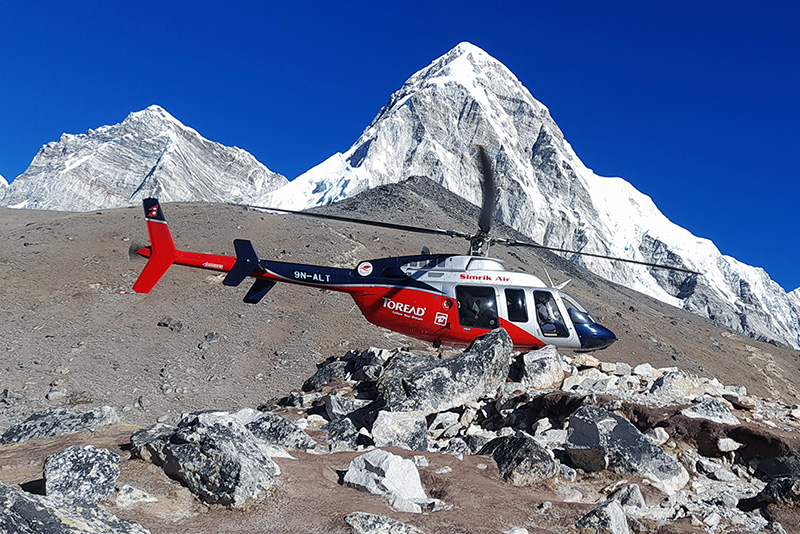
Everest Base Camp Helicopter Tour

Monastery Stay Tour
